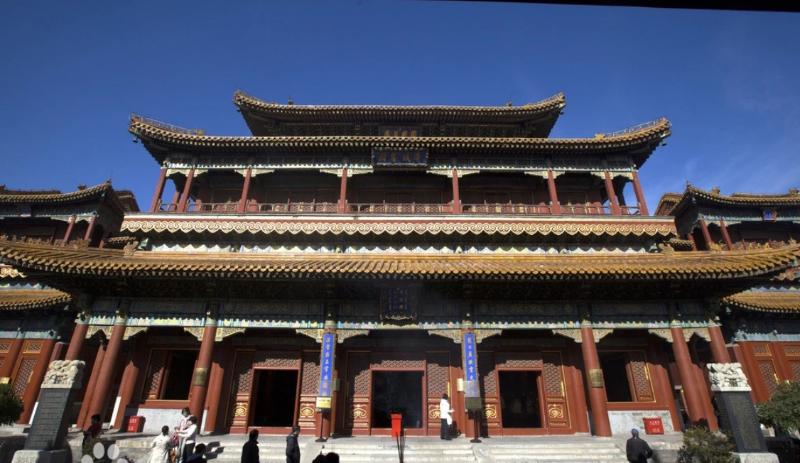Wanfu Pavilion: A Buddhist Treasure in Yonghe Temple
Wanfu Pavilion, located deep within Yonghe Temple, is not only a masterpiece of architectural art but also a treasure of Buddhist culture. Its existence adds a touch of mystery and grandeur to this ancient palace.

Reference: Yonghe Temple: A Cultural Gem of Buddhism in Beijing
I. Brief Introduction
Wanfu Pavilion is the fifth main hall of Yonghe Temple and the last main hall in the palace complex. This hall attracts countless visitors with its magnificent atmosphere and unique architectural style. The central main building soars into the sky, and its three-story design makes it stand out among the entire palace complex. The Yansui Pavilion and Yongkang Pavilion on the left and right sides, respectively, accompany the main building like two loyal guardians. They are closely connected to the main building by a corridor, forming a harmonious whole.
The name "Wanfu Pavilion" comes from the large number of small Buddha statues enshrined in the hall, reaching up to ten thousand, which perfectly embodies the meaning of "Buddha" and "blessing" here. The most eye-catching item in the pavilion is undoubtedly the Maitreya statue carved from a single piece of sandalwood. This Buddha statue is not only majestic in size but also carries significant meaning. It was carved from precious wood donated by the 7th Dalai Lama, representing the sublimity and holiness of Buddhism.
II. Main Structure
As the tallest and grandest hall in Yonghe Temple, Wanfu Pavilion impresses with its exquisite structure and unique design. The three-story design of the central main building gives the entire structure a magnificent appearance, while the two-story Yansui Pavilion and Yongkang Pavilion on the left and right sides cleverly complement the grandeur of the main building. These three pavilions are connected by flying corridors, making the entire architectural complex both integrated and distinctive. The golden and colorful decorations add a touch of gorgeousness and mystery to this hall.
III. Wooden Carving of Giant Buddha
When talking about the treasures of Wanfu Pavilion, one cannot ignore the wooden carving of the giant Buddha. This Maitreya Buddha statue stands 26 meters tall, with 8 meters underground. Such a huge Buddha statue is carved from a single piece of white sandalwood, demonstrating the craftsman's superb skills and profound foundation with exquisite craftsmanship and vivid forms. The Buddha statue holds a hada in its hand, with a majestic posture that seems to bless and bless the world. This wooden carving of the giant Buddha is not only known as one of the "three best" in Yonghe Temple but also represents the largest single wooden carved Buddha in China and the world.
IV. Construction Process
The construction of Wanfu Pavilion was arduous. Under the emperor's decree, the palace and Tibetan envoys went to great lengths to find a Buddha statue worthy of this hall. Finally, a tall white sandalwood was found in the Kingdom of Nepal and transported to the capital after a three-year long journey. Under the emperor's personal command, craftsmen from the Imperial Palace Yangxin Dianzao Banchu carefully constructed it over several months. The completion of this hall and the wooden carving of the giant Buddha not only demonstrates the majesty of imperial power but also reflects the profound culture of Buddhism.
V. Development and Changes
Over time, Wanfu Pavilion has experienced countless storms and changes in the long river of history. However, it has always stood firm, witnessing the rise and fall of Yonghe Temple and the inheritance and development of Buddhist culture. Nowadays, it has become an important Buddhist sacred place, attracting countless believers and tourists to worship and visit.
In summary, Wanfu Pavilion is not only an important building in Yonghe Temple but also a treasure and historical witness of Buddhist culture. Its existence allows us to pay more respect and homage to Buddhist culture. At the same time, it also allows us to feel the superb craftsmanship and infinite wisdom of ancient craftsmen.
Q&A
Q1: What is the significance of the name "Wanfu Pavilion" in Yonghe Temple?
A: The name "Wanfu Pavilion" comes from the fact that there are tens of thousands of small Buddha statues enshrined in the hall. The name embodies the perfect combination of "Buddha" and "blessing," signifying the blessings and protection brought by the Buddha.
Q2: What is the unique feature of the wooden carving of the giant Buddha in Wanfu Pavilion?
A: The wooden carving of the giant Buddha in Wanfu Pavilion is unique in that it is carved from a single piece of white sandalwood, standing 26 meters tall. The statue holds a hada in its hand, exuding a majestic presence. This carving not only demonstrates the superb skills of the craftsmen but also represents the largest single wooden carved Buddha in China and the world, showcasing the profound Buddhist culture.